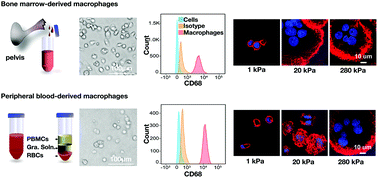Isolation and characterization of porcine macrophages and their inflammatory and fusion responses in different stiffness environments†
Abstract
Evaluating the host immune response to biomaterials is an essential step in the development of medical devices and tissue engineering strategies. To aid in this process, in vitro studies, whereby immune cells such as macrophages are cultured on biomaterials, can often expedite high throughput testing of many materials prior to implantation. While most studies to date utilize murine or human cells, the use of porcine macrophages has been less well described, despite the prevalent use of porcine models in medical device and tissue engineering development. In this study, we describe the isolation and characterization of porcine bone marrow- and peripheral blood-derived macrophages, and their interactions with biomaterials. We confirmed the expression of the macrophage surface markers CD68 and F4/80 and characterized the porcine macrophage response to the inflammatory stimulus, bacterial lipopolysaccharide. Finally, we investigated the inflammatory and fusion response of porcine macrophages cultured on different stiffness hydrogels, and we found that stiffer hydrogels enhanced inflammatory activation by more than two-fold and promoted fusion to form foreign body giant cells. Together, this study establishes the use of porcine macrophages in biomaterial testing and reveals a stiffness-dependent effect on biomaterial-induced giant cell formation.



 Please wait while we load your content...
Please wait while we load your content...